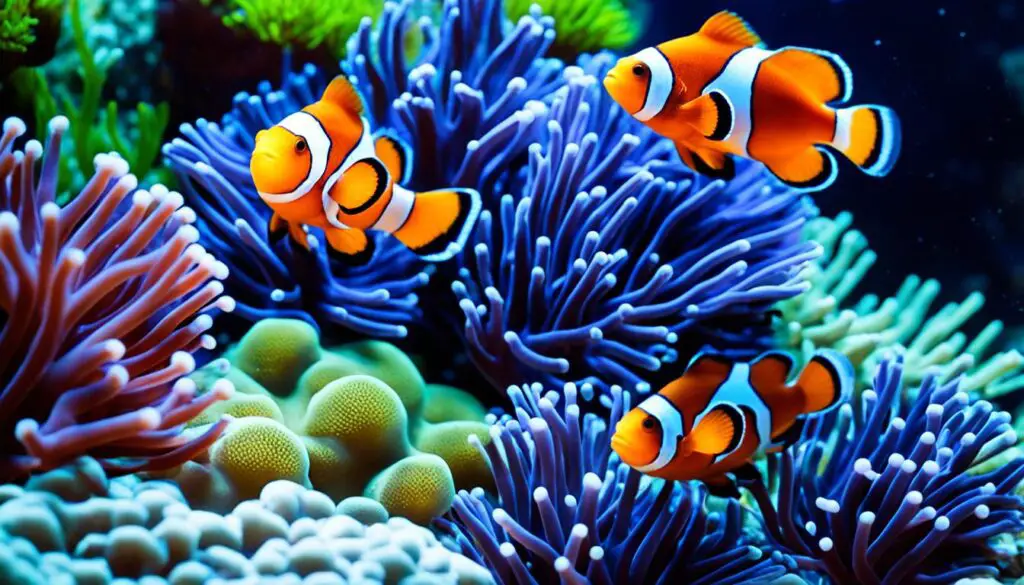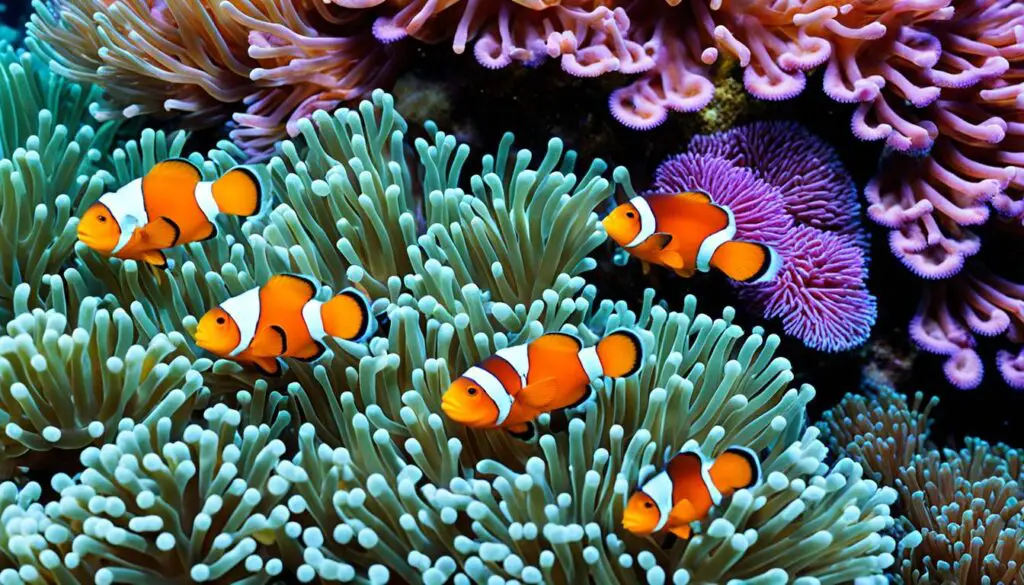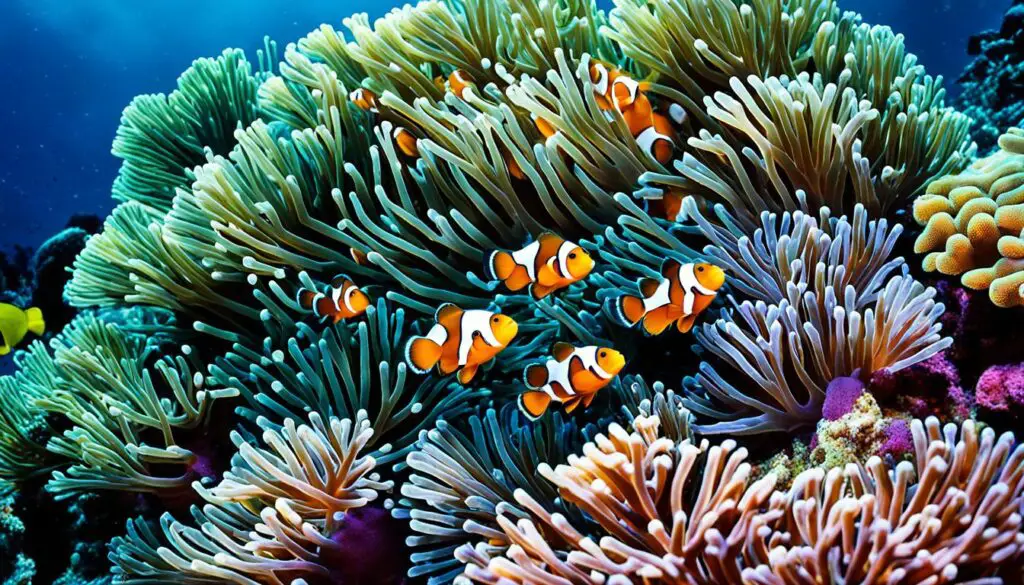Dive Deep into Reef Aquariums: Anemone Fish Edition
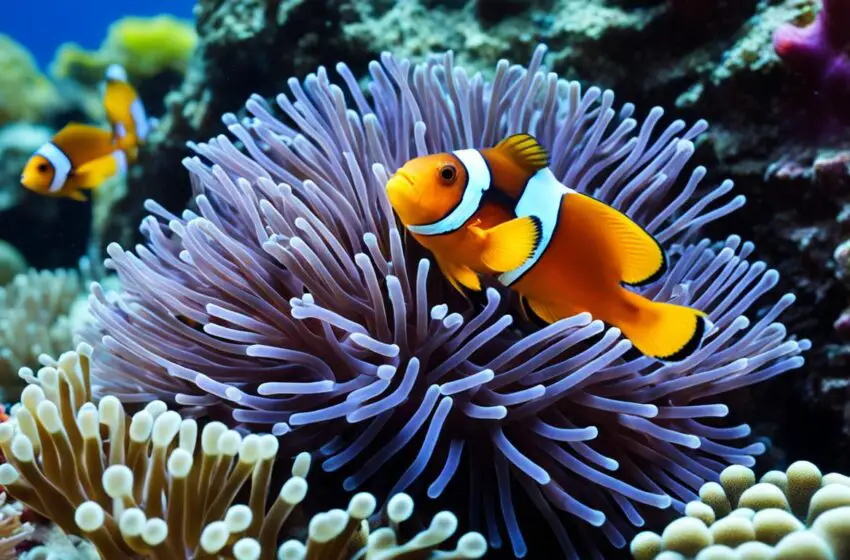
Welcome to Steinhart Aquarium in San Francisco. It’s a special place full of life and excitement. Today, we’ll explore the amazing world of anemone fish. These colorful, enchanting creatures are loved by many.
Steinhart Aquarium is more than just any place to see fish. It is home to almost 60,000 animals and 1,000 species. You’ll get a close look at the beauty of our oceans and forests. This experience makes you care deeply about these environments.
This aquarium is known for its groundbreaking work. For example, it first exhibited flashlight fish and coconut octopuses. Each visit brings you face to face with new, incredible species. You’ll see exhibits that are changing what we know about life underwater.
Steinhart Aquarium aims to educate and inspire. They know that learning can lead to a better world. They work hard to show why it’s important to protect different creatures and the places they live.
Now, let’s focus on anemone fish. We’ll learn how to set up a perfect tank for them. And we’ll admire the stunning nature of these fish and the care they need.
Key Takeaways:
- Aquarium setup plays a crucial role in creating a thriving reef environment.
- The Steinhart Aquarium in San Francisco offers an immersive and diverse experience with its wide array of live animals and species.
- Anemone fish are captivating creatures that require special care and attention in aquariums.
- Through education and inspiration, Steinhart Aquarium aims to raise awareness about the importance of biodiversity and sustainability.
- Creating a suitable environment for anemone fish involves thoughtful tank setup, lighting, and filtration choices, among other factors.
Setting Up an Anemone Tank: Tips and Tricks
Exploring the anemone fish world is thrilling, especially setting up their tank. You need to think about tank size, materials, lighting, filtration, and setup. Below are tips to help your anemone tank do well.
Tank Size and Materials
The right tank size is vital for your anemone and its fish. Many choose the 40 breeder tank for its space. It’s also nice to reseal the tank with black silicone. This boosts looks and safety.
The Bare Bottom Approach
Many like the bare bottom setup for anemone tanks. It means no sand or gravel on the tank bottom. This setup is easier to clean and highlights the anemone’s beauty. Also, it keeps the anemone safe from harmful particles.
A Sturdy and Cost-Effective Stand
“A solid foundation is the key to success when it comes to anemone tank setup.”
A strong stand is crucial for a stable tank. You can save money by making a stand with cinderblocks, planks, and plywood. This kit can hold the tank’s weight and gear well.
Lighting and Filtration
Top-notch lighting and skimmer filtration are essential for anemones and fish. For lighting, consider the Kessil A160W Tuna Blue or Aquatic Life T5 Hybrid. They provide the right light for plant growth and anemone color.
For filtration, the Hydor Performer 2005 skimmer works well. This skimmer keeps the water clean by removing waste and organics.
Anemone Tank Setup Recommendations
| Tank Size | Materials | Lighting | Filtration |
|---|---|---|---|
| 40 breeder tank | Resealed with black silicone | Kessil A160W Tuna Blue or Aquatic Life T5 Hybrid | Hydor Performer 2005 skimmer |
For a great setup, add a sump with space for chaeto algae and brightwell bricks. These help the tank stay stable and healthy over time.
With the right approach, your anemone tank can be a perfect home for these fascinating creatures. Your anemone fish, alongside their sea anemones, will look beautiful.
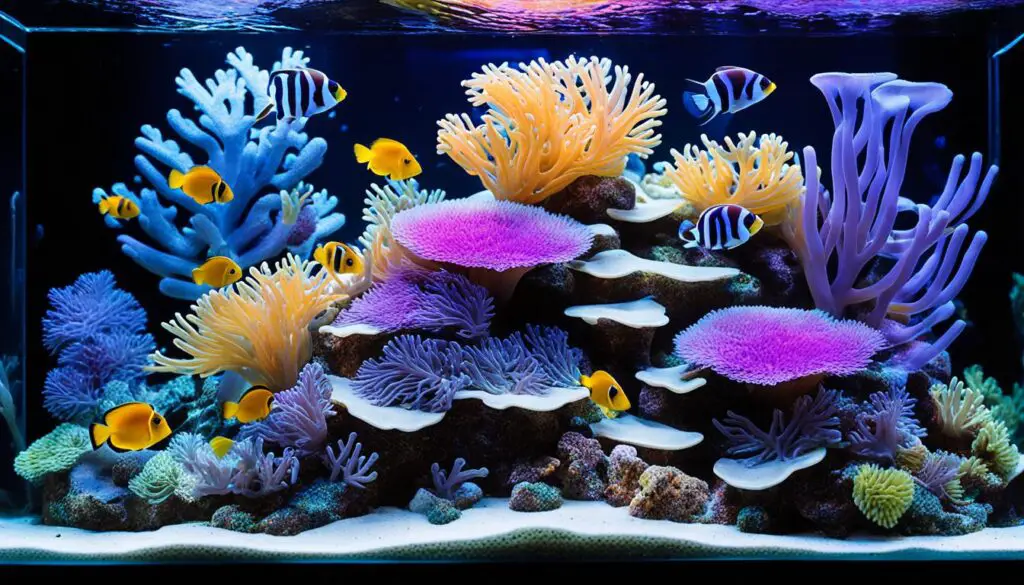
Anemone Fish Species: Identification and Care
Clownfish, also called anemone fish, are known for their special relationship with sea anemones. They are found in the world’s warm oceans, near various coral reefs. Different types of clownfish have their distinct looks and needs.
Some well-known clownfish types are:
- Amphiprion ocellaris
- Amphiprion percula
- Premnas biaculeatus
They live in warm waters near coral reefs of the Indian and Pacific Oceans. In tanks, they require the right anemone hosts to stay healthy and happy.
Clownfish are tough and can adjust easily to different tanks. Yet, they do need special care to live well and thrive.
Here are some top care tips for anemone fish:
- Habitat: Set up a tank that feels like their natural home. Add plenty of hiding spots and rocks to make it look like the sea.
- Feeding: Give them a mixed diet, including frozen foods and quality pellets. Feed them several small meals each day because they eat whenever food is available.
- Water Quality Maintenance: Clownfish do best in clean and stable water. Change the water regularly, use a good filter, and check the water’s temperature and salt levels often. Keep the levels of ammonia, nitrite, and nitrate in check too.
- Behavior Observation: Watch your fish regularly. Notice any changes in how they act, eat, or look. These changes might point to a health problem.
Creating a peaceful and stable home for clownfish is key to their care. By learning about their needs and giving them the right care, you can enjoy their beauty and behavior at home.
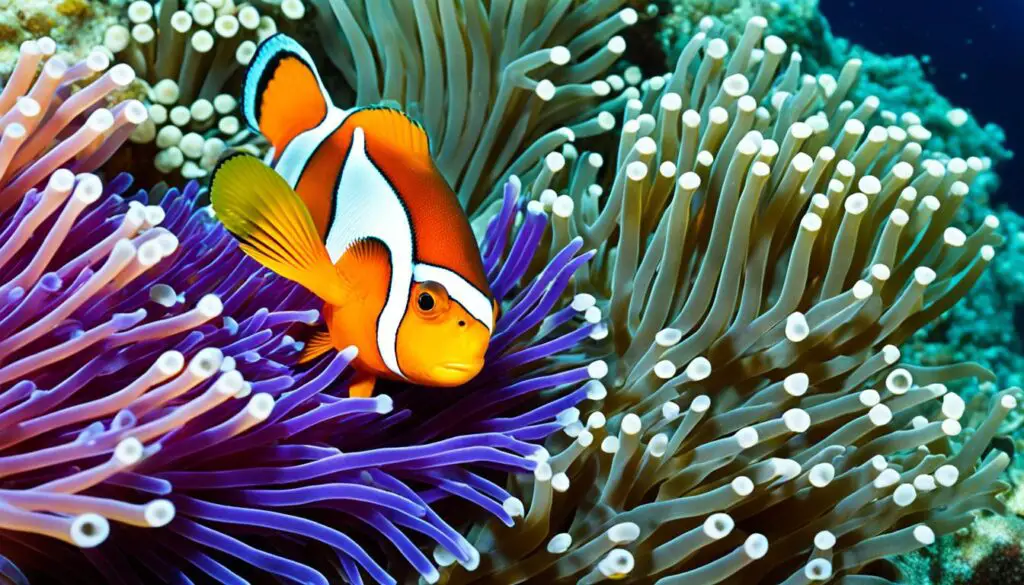
Did You Know?
Anemone fish are well-known for their ability to change sex. These sequential hermaphrodites can switch from one sex to another based on specific social cues. In a group of anemone fish, the largest individual is typically a female. The second-largest becomes a male. If the female dies, the male changes sex and takes her role.
Conclusion
Steinhart Aquarium takes you on a journey through stunning ocean and rainforest worlds. Its displays and lessons make people of any age value and save the rich life in our water.
The aquarium puts a big focus on protecting endangered animals and where they live. Whether it’s Methuselah, the tough Australian lungfish, or helping to save vital coral reefs, the aquarium leads in teaching and saving nature.
It uses cool exhibits, careful animal keeping, and science dives to show how important saving nature is. Every visit helps in the mission to protect the beauty of our planet for those who come after us.
FAQ
What size tank should I use for an anemone setup?
A 40 gallon breeder tank is a great choice. It offers good space and is practical.
Should I reseal the tank with black silicone?
Yes, using black silicone to reseal your tank is a good idea. It keeps things safe and looks nice too.
What type of tank setup is preferred for anemones?
Go for a bare bottom tank setup. It makes maintenance easy and lets you show off your rockwork.
What is a cost-effective option for an aquarium stand?
For a low-cost but sturdy stand, use cinderblocks, planks, and plywood. It won’t break the bank and keeps your tank steady.
What lighting and filtration systems are recommended for an anemone tank?
For lighting, consider the Kessil A160W Tuna Blue or an Aquatic Life T5 Hybrid. The Hydor Performer 2005 skimmer is a good choice for filtration.
Should I use a sump with my anemone tank?
Yes, using a sump is a smart choice. It lets you grow chaeto and use brightwell bricks for bacteria filtering.
What are some common species of anemone fish?
Common types include the Amphiprion ocellaris, the Amphiprion percula, and the Premnas biaculeatus.
Where do anemone fish prefer to live?
They love the warm waters of the Indian and Pacific Oceans. You’ll find them near coral reefs.
How hardy are anemone fish in aquarium environments?
Anemone fish are quite tough and do well in aquariums.
Why is a suitable anemone host important for anemone fish?
Having a right anemone is vital for the health of these fish.
What are the key factors for successful care of anemone fish?
Giving them the right food, clean water, and watching them closely is key to their care.

